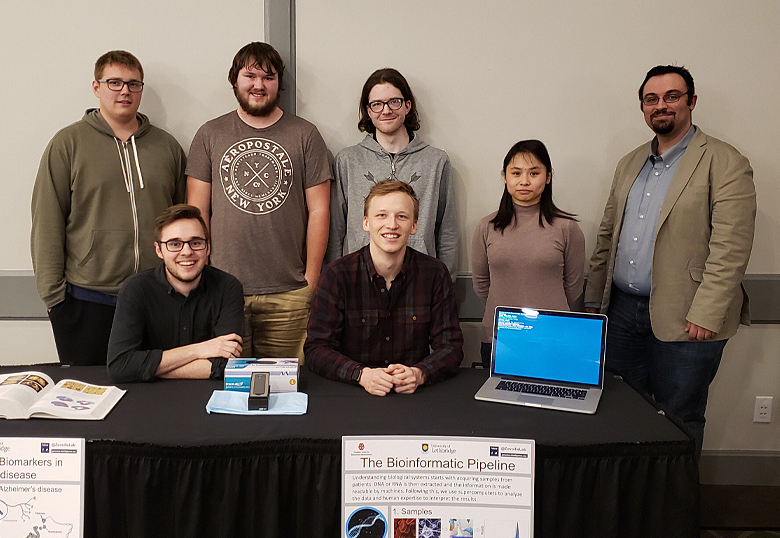Albertan research shines light on dementia

Photo by University of Lethbridge
Graduate students play an important role in Zovoilis's research into Alzheimer's disease. Bottom row, left to right, are Luke Saville, Chris Isaac and Yubo Cheng. Top row, left to right, are Travis Haight, Cody Turner and Liam Mitchell.
University of Lethbridge researchers have shed some light on the complex processes behind dementia — potentially leading to better understanding and treating the debilitating condition.
Genome scientists at the U of L, led by Dr. Athan Zovoilis, were recently published in a prestigious biomedical journal called “eLife” as part of work done at the new Southern Alberta Genome Sciences Centre.
It approached unresolved questions regarding a set of biological particles known as “SINE non-coding RNAs.”
These particles are known as the “dark matter” of human DNA, and have recently discovered to be an important part in the function of our bodies’ cells.
The research done by Zovoilis and his team have shown these particles are connected to neurodegenerative conditions such as Alzheimer’s disease and dementia.
“These RNA molecules are integral parts of the function of healthy brain cells,” said Zovoilis. “However, in Alzheimer’s disease, [these RNA molecules] become over-responsive, creating a vicious circle that, instead of the protecting the human brain, finally leads to to death of brain cells.”
“Finding a way to bypass this vicious cycle is vital for finding ways to delay or even prevent the development of this disease.”
Alzheimer’s disease is the most common cause of vital decline in older adult populations.
More than 44 million individuals currently live with Alzheimer’s or comparable dementia across the world and costs related to its treatment and effects are in the excess of $12 billion in Canada.
Some treatments exist to treat and improve the symptoms of neurodegenerative conditions, but these effects are either temporary or only slow the process of its effects.
Currently, no cure or way to reliably detect early risk indicators for Alzheimer’s exists and the underlying causes are still unclear.
The study conducted by Zovoilis and his team use technologies that can “read all the pages of DNA” like a book in a matter of hours, and are used to focus on the complex and voluminous amounts of information encoded into human genetic material.”
Our results have revealed the broad role of SINE RNAs in molecular pathology in the brain,” Zovoilis said. “This has significant implications for conditions such as Alzheimer’s disease.
“The research continues as the team now aims their research and their findings in human patients in further studies.
This additional study, along with the original one that revealed these findings, were in part funded by the Alberta Prion Research Institute and the Alzheimer’s Society of Alberta and Northwest Territories.
